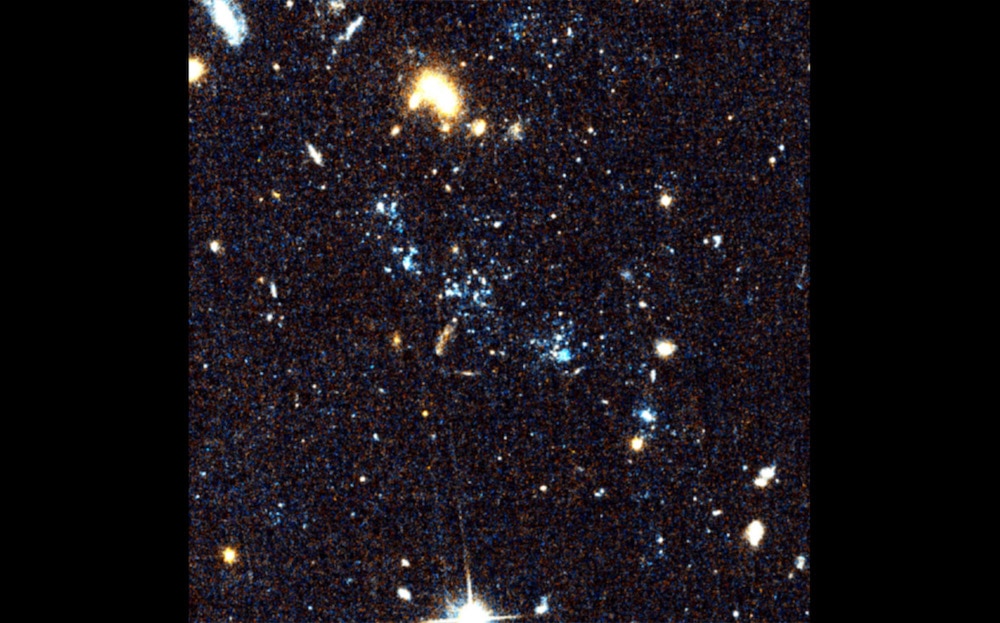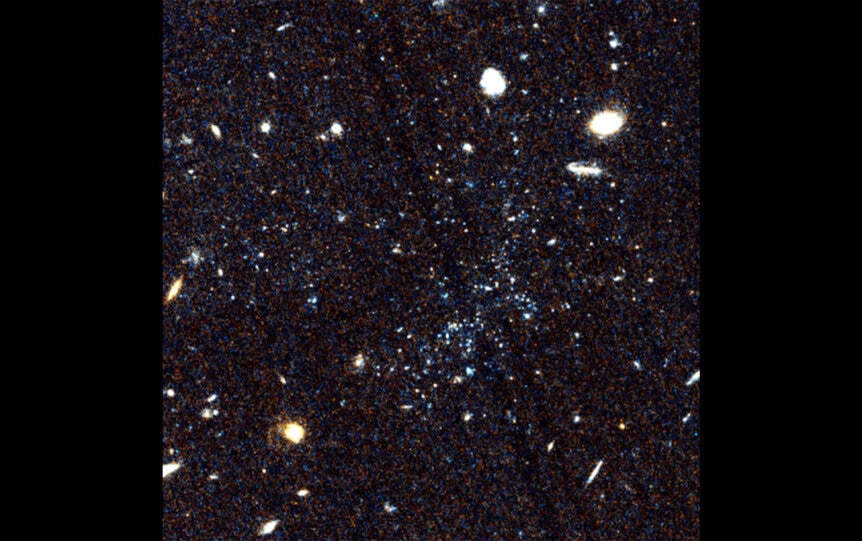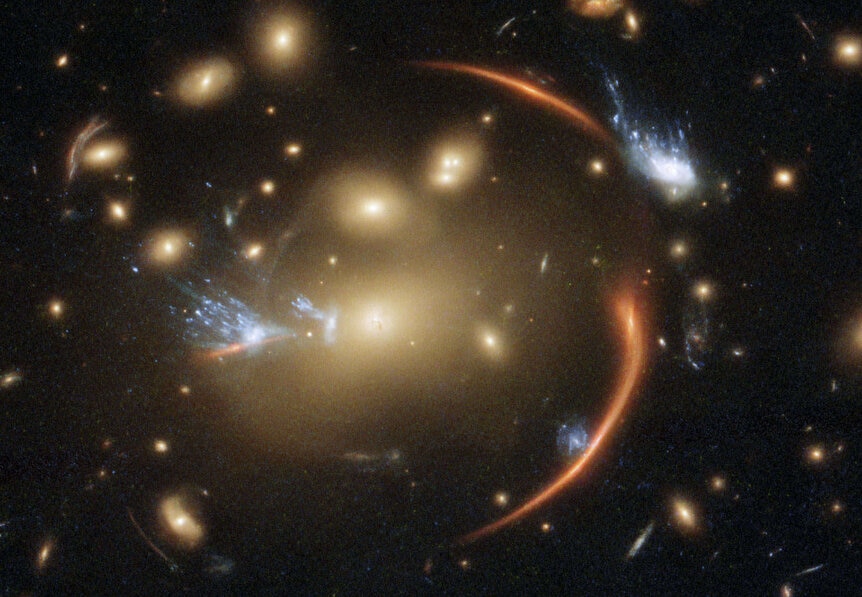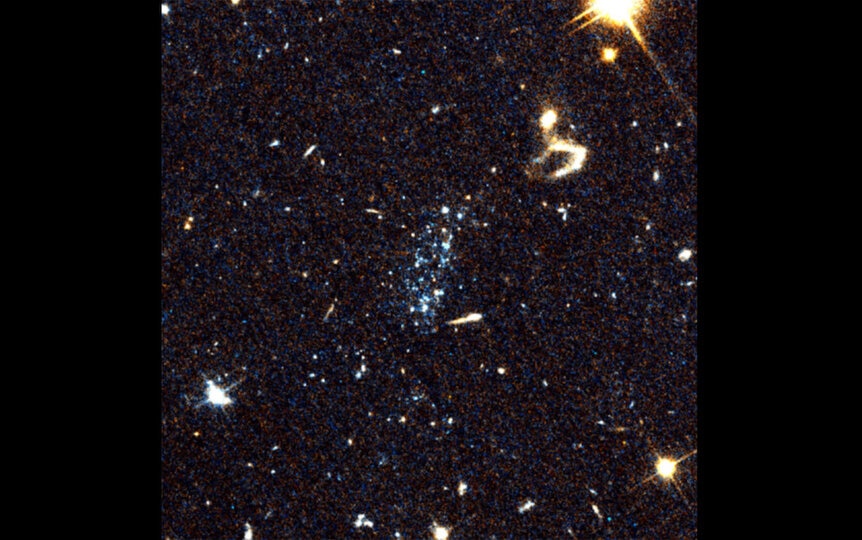Create a free profile to get unlimited access to exclusive videos, sweepstakes, and more!
Blue blobs turn out to be orphan star clusters made of gas cast-off from galaxies
Stripped gas condenses to form massive blue stars.

Astronomers have discovered a new kind of star system: Elongated and clumpy clusters of young, hot, blue stars, formed out of gas blown out of a galaxy as it rams its way through a galaxy cluster.
Everything about that sentence is awesome.
While these stellar systems were found on purpose — in that the astronomers were looking for them — they turned out not to be what the astronomers were expecting, adding a little bit more fun to this whole story [link to paper].
We live in the Milky Way, a huge galaxy that’s part of a small collection of a few dozen nearby galaxies we call the Local Group. Radio-wave surveys of the sky show a lot of very small, fast-moving clouds of atomic hydrogen gas that were suspected to be either part of the Milky Way or the Local Group. Astronomers thought these clouds may be collapsing to form stars, and actually small galaxies.
However, initial visible-light observations didn’t show much. They just looked like blue blobs. But then deep observations of one cloud showed it was indeed forming stars. It was named SECCO-1, for StEllar Counterpart of Compact high-velocity clouds. However, they concluded this wasn’t actually part of the Milky Way or the Local Group, but was instead much farther away, part of the Virgo Cluster of galaxies about 60 million light years away!
The Virgo Cluster has thousands of big galaxies in it, and a lot of gas floating around. Encouraged by the initial results, more observations of these hydrogen clouds were made, using the Very Large Array for more detailed radio maps, the enormous Very Large Telescope (or VLT) for spectroscopy, and Hubble Space Telescope for images. They targeted gas clouds that also had ultraviolet emission as seen by the GALEX observatory, which indicates likely star formation.
They targeted five such clouds. One turned out to be a knot of distant background galaxies, which is a little disappointing. But the other four were resolved by Hubble into stars, showing these actually are clumps of stars in space. While they cannot prove they are part of the Virgo Cluster, their brightness and velocities are consistent with that. It seems pretty clear they are indeed inside the cluster.
But what are they? They’re weird. The objects are clumpy, elongated, and have warm hydrogen gas in them consistent with star formation. All the stars are blue, indicating they’re young and massive. And while they were originally found due to being seen in maps of atomic hydrogen, only one of them, called BC3, appears to have a lot of this gas; the rest are deficient in it.
They see no bright red stars, another sign the systems are young. When stars like the Sun die they expand into luminous red giants. That can take billions of years, but for massive stars it may only be some tens of millions of years. Seeing none means these systems are really young.
They’re also fairly low mass, with less than 100,000 times the mass of the Sun’s worth of stars in them. That may sound like a lot but galaxies have millions or many billions of solar masses in them, and even globular clusters tend to have several hundred thousand solar masses. Globulars are compact, a few light-years across, but these objects are several thousand to about 20,000 light-years long, and are elongated.
So what are they? Gas clouds just floating around in intergalactic space don’t generally collapse to form things like these. But these aren’t just out between galaxies, they’re between galaxies in a massive galaxy cluster.
That environment makes a huge difference. Galaxies in the cluster all orbit one another due to their gravity. A gas-rich galaxy plunging through the cluster can be moving at speeds of many hundreds of kilometers per second — millions of kilometers per hour — and when they do they experience a lot of pressure exerted by the thin gas between galaxies. This can strip out the gas inside a fast-moving galaxy, in much the same way you can air out a car while driving by opening the windows. This type of thing is called ram pressure stripping.
We see a lot of this going on in many galaxy clusters including the Virgo Cluster, and in fact some galaxies are moving so rapidly they’re losing a significant amount of gas. This orphaned gas can get compressed as it is blown back and moves behind its parent galaxy, and form stars as it does so. This also would explain why these new systems are elongated — that’s a natural outcome of them plowing through the intracluster gas — and why they’re also relatively isolated, not near any other galaxies. Their parent galaxies long since left them behind.
They formed in dramatic fashion, but their fate is to dissolve. Given their individual total masses, they probably aren’t gravitationally bound; in other words over time the stars in these systems will fly away, becoming isolated stars in the Virgo Cluster between the galaxies. The astronomers estimate the stellar clusters won’t last more than 500 million years, which is short compared to the lifetime of the galaxy cluster. That also means these systems are probably being formed continuously as gas is stripped from galaxies. If there were some singular short-term event that made these objects then they likely would have dissipated ages ago.
If all this is true — and the evidence sure points this way — then these truly are a new kind of star cluster. Formed as gas is ripped from galaxies that in turn forms stars, they eventually evaporate, over time peppering the cluster with millions of rogue stars.
That’s amazing, and a wonderful indication that we still have much to learn about the way the Universe makes stars. Mind you we only saw these objects because they happen to be nearby; in more distant clusters they’d be too faint to see clearly with current technology.
What else is going on in the corners of the Universe too far away to inspect carefully?






























